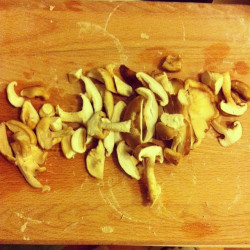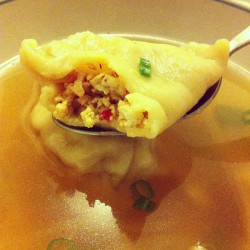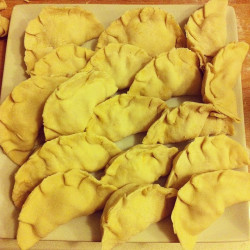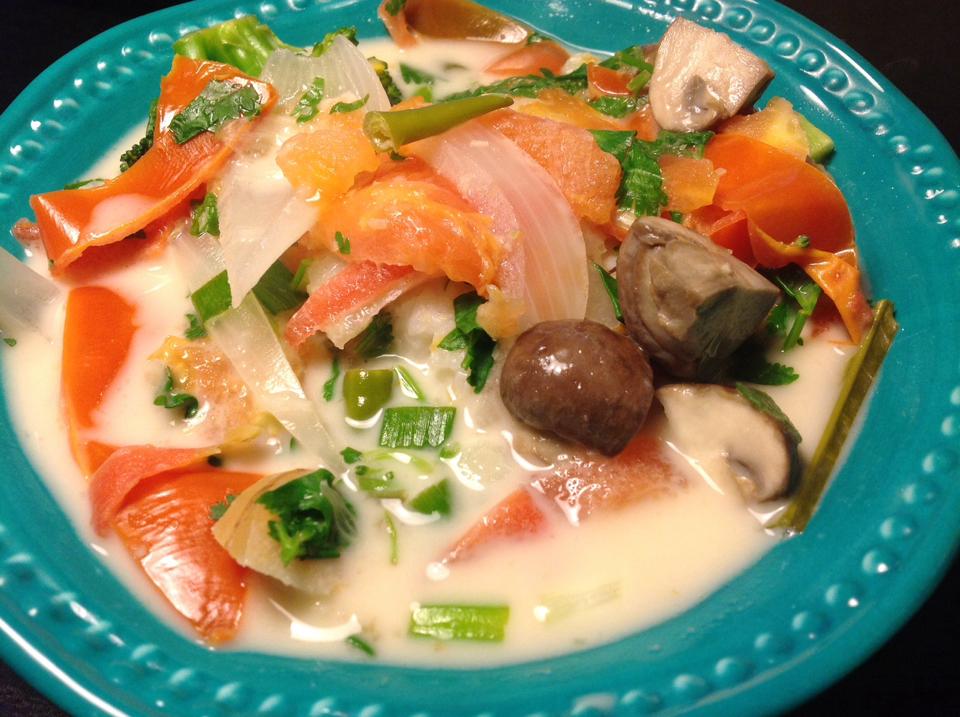Happy Lunar New Year! Also known as Chinese New Year, today is the first day of 2014 according to the Lunar Calendar–and it’s the biggest traditional feast day for the Koreans.
In every culture, it seems, there is a recipe for the New Year that is supposed to bring good luck and prosperity. Koreans eat a bowl of rice cake soup on New Year’s morning, called dduk guk. This soup is often enhanced with some handmade dumplings–but as a kid, I always thought dduk guk would be a lot better if it had way more dumplings and less rice cakes.
So last night I set to work creating a purely dumpling soup, with shiitake mushroom broth instead of the traditional beef-based broth. Now I understand why there were fewer dumplings than rice cakes…they take a lot of effort to make from scratch! (Thanks, Mom!) While rolling the dough, I had to sustain myself by stealing spoonfuls of the delicious, delicious filling. But the effort was well worth it when I took a picture of my dumpling babies, all waiting to go into the broth, and sent it to my mom. She heartily approved of them, and once you taste them, you’ll see why.
Tip #1: Roll the dough as thinly as possible, and then flatten it out some more. The skin is best when it’s paper thin.
Tip #2: The filling should be saltier than you think. Even though the kimchi will make you think it doesn’t need extra salt, trust me.
Korean Dumpling Soup (mandu guk)
Makes 18-22 dumplings
Dough
1 1/2 cups white flour
1/2 cup rice flour (I used brown rice)
1 tbsp corn starch
1 1/4 cup cold water, plus a few more tbsp as needed
Filling
1 block extra firm tofu, drained well
3/4 cup kimchi, chopped
2 tbsp nutritional yeast
1/2 cup reconstituted textured vegetable protein (about 1/3 cup dried)
Salt and pepper to taste
Broth
1 cup shiitake mushrooms, sliced
1/4 cup dried shiitake mushrooms
1 small onion
3-4 cloves garlic, sliced
2-3 stalks of scallion, chopped (green and white parts)
2 tbsp soy sauce
1 tsp sesame seed oil
about 2 quarts water
Salt and pepper
1. In a large bowl, mix the flours, corn starch, and water together to form a dough ball. It should be fairly dry; but press it together into a big ball, wrap in cling wrap, and put in the fridge to chill.
2. Meanwhile, drain the tofu by holding it over the sink and squeezing gently. (It’s fun!) In a large bowl, crumble the tofu. Add chopped kimchi, nutritional yeast, reconstituted TVP (follow instructions on the packaging, but usually it’s just adding some boiling water and letting it sit for 5-10 minutes). Mix with a spoon, and salt and pepper. Resist the urge to just eat the filling.
3. Take the dough out and put on a wooden block with some flour to prevent sticking. Take about 1/2 of the ball and use a rolling pin to roll it out very thinly. Use a cup to cut out the skins–it should be about 3 or 3.5″ in diameter, and paper thin.
4. Once you have all the skins ready, it’s time to make the dumplings! Put about 2 tbsp filling in the middle of the skin, and fold in half. You can make a pretty pleated edge, which is traditional.
5. In a large pot, bring about 2 quarts water to boil–I didn’t measure the water, but it should be about half the pot. Add the onions, garlic, and both fresh and reconstituted shiitake mushrooms. (Add the water from dried shiitake mushrooms too). Once it is boiling, add the soy sauce and sesame oil and turn the heat down to low.

4. Now you’re ready to add the dumplings. Depending on your pot and appetite, add 12-18 dumplings. They’re ready when they rise to the surface–about 8-10 minutes. A few minutes before you turn off the heat, add the scallions.
 And there you have it! You can garnish with some more fresh chopped scallion, or even toasted nori strips. You are now one year older! Happy New Year!
And there you have it! You can garnish with some more fresh chopped scallion, or even toasted nori strips. You are now one year older! Happy New Year!
Related Recipes: Vegan Black Eyed Peas with Greens
Our first Dumpling recipe – Korean Dumplings (Mandu)
Photo: Peaceful Dumpling






